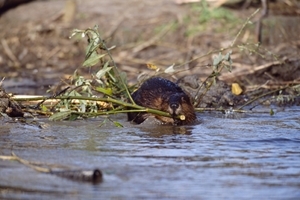Does it really make sense in our countryside?
03/04/2009
 Last month Natural England and the People's Trust for Endangered Species published a report on the feasibility of reintroducing beavers to England. At 106 pages this is a pretty comprehensive review of beaver ecology. The authors quite sensibly include American as well as European beavers in their discussion because, even though the two animals are distinct species, they are ecologically and behaviourally identical. While this part of the report is useful and certainly full enough to give one a good impression of what beavers are about, the report is less even handed when assessing the desirability or otherwise of reintroducing them into England. Indeed it gives a distinctly rose-tinted view of their likely impact. The various “benefits” of having beavers are presented as established facts, whereas the potential disadvantages are viewed as “stakeholder concerns” that need to be allayed. In some places the appraisal is certainly suspect; for example in one German cost-benefit analysis the costs presented are real ones incurred by a reintroduction programme, but the benefits are mostly an imaginary income based on a perception of the public’s willingness to pay.
Last month Natural England and the People's Trust for Endangered Species published a report on the feasibility of reintroducing beavers to England. At 106 pages this is a pretty comprehensive review of beaver ecology. The authors quite sensibly include American as well as European beavers in their discussion because, even though the two animals are distinct species, they are ecologically and behaviourally identical. While this part of the report is useful and certainly full enough to give one a good impression of what beavers are about, the report is less even handed when assessing the desirability or otherwise of reintroducing them into England. Indeed it gives a distinctly rose-tinted view of their likely impact. The various “benefits” of having beavers are presented as established facts, whereas the potential disadvantages are viewed as “stakeholder concerns” that need to be allayed. In some places the appraisal is certainly suspect; for example in one German cost-benefit analysis the costs presented are real ones incurred by a reintroduction programme, but the benefits are mostly an imaginary income based on a perception of the public’s willingness to pay.
The report also raises more questions than it answers. For example, one of the many arguments for introducing these “ecosystem engineers” is that their dams and ponds will help control floods and reduce the silt loads from upper river catchments; yet, in the analysis of potential locations for a reintroduction in England these areas are excluded and low gradient flood plain rivers, where beavers are less likely to build dams, are chosen instead. One chapter that is very clear is the one on the legal situation – in summary it is legal nightmare. As it stands now a farmer can shoot or trap an escaped beaver without breaking any law, but should he pick it up and “possess” it he commits a crime. Similarly to deliberately release beavers into the wild is unlawful, but should such an unlawful release lead to beavers becoming established (presumably breeding) then any further releases would be quite lawful. Indeed once established, under European law the British government would be obliged to give them full protection.
Beavers are wonderful creatures and in wilderness areas they truly do enhance biodiversity by modifying rivers and streams. In the managed English countryside, once the novelty wears off, they are likely to be regarded more of an expensive nuisance than an asset. In North America in the 1980s (in a review not referred to in the Natural England report) the damage caused by beavers was estimated at some $100 million annually which was well in excess of the revenue that they generated as a fur-bearer at the time.